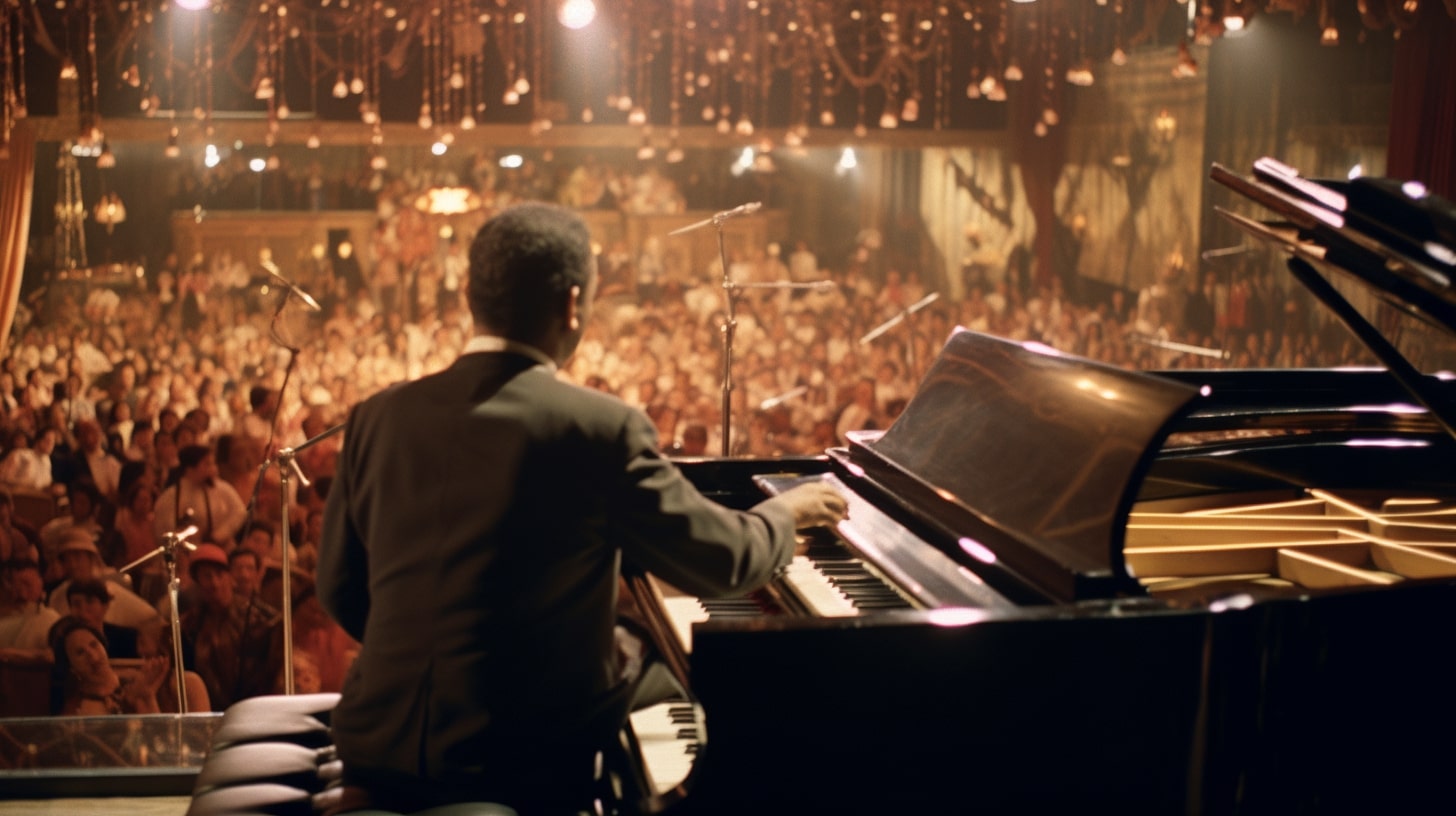Duke Ellington was an influential figure in the world of jazz. Throughout his life and career, Ellington led his eponymous jazz orchestra, leaving a lasting legacy with his innovative compositions and arrangements.
By emphasizing each instrument’s distinct capabilities, Ellington produced a rich and innovative sound that continues to inspire jazz enthusiasts and musicians alike.
Contents
Duke Ellington’s Early Life and Career
Childhood in Washington, D.C.
Duke Ellington, born as Edward Kennedy Ellington, was brought into the world on April 29, 1899, in Washington, D.C. He was born to James Edward Ellington and Daisy Kennedy.
Both of his parents were musicians, which likely influenced Ellington’s early interest in music. During his childhood in Washington, D.C., Ellington was exposed to a vibrant musical culture that would shape his artistic sensibilities.
Music Beginnings with Soda Fountain Rag
Duke Ellington’s musical journey started when he took piano lessons at a young age. In the early stages of his career, he was inspired by local ragtime pianists in Washington, D.C. At the age of 15, Ellington composed his first piece, “Soda Fountain Rag,” which he claimed to have created while working at a soda fountain. This composition showcased his aptitude for music and his potential as a composer.
In the mid-1920s, Ellington moved to New York City, where he eventually formed his famous big band. He gained national prominence through the orchestra’s performances at the illustrious Cotton Club in Harlem. Throughout his career, Ellington became known for his innovative compositions and exceptional pianist skill.
Duke Ellington’s early life and career were marked by a dedication to his craft and the cultivation of his unique talents, which ultimately contributed to his status as one of the most significant figures in jazz history.
The Cotton Club Era
Overview of The Cotton Club
The Cotton Club was a legendary nightspot in the Harlem district of New York City, which featured prominent Black entertainers performing for white audiences. This club served as a springboard to fame for many artists, including Duke Ellington and Cab Calloway.
New York City and The Washingtonians
In the mid-1920s, Duke Ellington moved to New York City, where he eventually became the leader of a jazz orchestra called The Washingtonians.
During this time, his orchestra gained a national profile through their appearances at the Cotton Club, a venue that would play a significant role in shaping Ellington’s career.
Development of Unique Sound and Style
While at the Cotton Club, Ellington’s orchestra served as the house band starting in 1927. During this period, Ellington developed a unique sound and style that would eventually become synonymous with his name. The residency at the Cotton Club provided Ellington with a platform to experiment and craft his distinctive approach to jazz music, which combined elements of swing, blues, and big band. This period marked a pivotal point in Ellington’s career, laying the foundation for his future successes as a composer and bandleader.
Ellington played the piano, which he used to lead his orchestra, and he was often the centerpiece of his performances. Over the years, he crafted a vast and diverse repertoire that showcased his talents as a pianist, composer, and arranger.
Musical Contributions and Accomplishments
Notable Compositions
Duke Ellington, a pioneering jazz musician, and composer, was widely recognized for his extensive contributions to the world of music. Throughout his career, he composed thousands of scores, creating a distinctive ensemble sound in Western music. Some of his most popular and influential songs include “It Don’t Mean a Thing (If It Ain’t Got That Swing),” “Take the ‘A’ Train,” “Mood Indigo,” “Sophisticated Lady,” and “Black and Tan Fantasy.”
Between 1939 and 1942, Ellington also crafted groundbreaking pieces like “Jack the Bear,” “Ko-Ko,” and “Cotton Tail.” These compositions continue to inspire jazz musicians today.
Collaborations with Billy Strayhorn
One of Duke Ellington’s most significant and fruitful partnerships from 1939 to the end of his career was with composer and pianist Billy Strayhorn. Strayhorn collaborated with Ellington to create numerous acclaimed musical works. Together, they produced the iconic jazz standard “Take the ‘A’ Train,” which became the signature theme of the Duke Ellington Orchestra.
The pairing of Ellington and Strayhorn resulted in other remarkable compositions such as “Chelsea Bridge,” “Lush Life,” and “Satin Doll.” Their professional relationship greatly influenced both jazz and big band music throughout their careers.
Influence on Jazz Musicians and Composers
Duke Ellington’s groundbreaking compositions and unique approach to big band music left a lasting impact on countless musicians and composers. As one of the originators of big-band jazz, Ellington brought attention to the genre and helped to shape its evolution over time.
Ellington’s innovative musical style inspired many other jazz artists, such as Thelonious Monk, Charles Mingus, and Count Basie. His influence extended beyond jazz, impacting composers across various genres and illustrating his enduring significance in the world of music.
The Duke Ellington Orchestra
Prominent Musicians and Instrumentalists
The Duke Ellington Orchestra consisted of various outstanding musicians during its existence. Some of the band’s key members included saxophonist Johnny Hodges, trumpeter Cootie Williams, bassist Jimmy Blanton, and tenor saxophonist Ben Webster. These instrumentalists greatly contributed to the success and unique sound of the orchestra.
Evolution of the Band
The Duke Ellington Orchestra evolved significantly over its many years of existence. Starting in the 1920s, the band played primarily jazz and swing music. By the 1930s and 1940s, the orchestra had grown to include numerous skilled musicians, solidifying its reputation as one of the premier jazz bands in America. Throughout these years, the band continued introducing new styles and arrangements, exploring the full potential of jazz music.
Newport Jazz Festival Performance
In 1956, the Duke Ellington Orchestra delivered a legendary performance at the Newport Jazz Festival. This widely acclaimed concert rejuvenated Ellington’s career and introduced his music to a new generation of fans.
The orchestra’s captivating performance showcased its musicians’ timeless quality and versatility, many of whom would go on to have long, successful careers.
Beyond
After the Newport Jazz Festival, the Duke Ellington Orchestra continued to innovate and experiment with new sounds and styles. Ellington’s compositions and arrangements became more complex and sophisticated, often incorporating elements of classical music and world genres. Despite this evolution, the core spirit of the orchestra remained rooted in the jazz tradition.
With Duke Ellington’s passing in 1974, the band became a testament to his enduring musical legacy, continuing to perform and celebrate the rich history of jazz music.
Ellington’s Pivotal Role as a Pianist
Impact on Jazz Piano
Duke Ellington became one of the most influential jazz musicians of his time. His impact on jazz piano can’t be overstated, as he not only popularized the genre but also contributed significantly to its evolution.
As a pianist, Ellington had a distinct style that set him apart from other players at the time, and his enduring legacy still resonates in the jazz community today.
Innovative Techniques and Style
Ellington’s innovative techniques and style helped redefine the role of the piano in jazz music. He was known for his unique chord voicings, use of contrasting rhythms, and incorporation of various musical textures. These characteristics of Ellington’s playing ultimately expanded the possibilities for the jazz pianist, encouraging experimentation and exploration of new musical ideas.
One key aspect of his playing style was his use of “call and response” between the piano and other instruments in the ensemble. This conversational approach to jazz paved the way for more collaborative and expressive performances.
Duke Ellington’s focus on orchestration allowed for a greater emphasis on the individual voices of his band members, creating a cohesive and dynamic sound.
Collaborations with Notable Pianists
Throughout his career, Duke Ellington collaborated with numerous notable musicians, including celebrated pianists. One such collaboration was with Charles Mingus, a renowned bassist and composer. The two musicians recorded an album together in 1962 titled “Money Jungle,” featuring Mingus on bass, Duke Ellington on piano, and Max Roach on drums. This iconic trio showcased the skills of each musician and highlighted the rapport between Ellington and Mingus.
These collaborations allowed Ellington to continue pushing the boundaries of jazz piano and contribute to the genre’s ongoing evolution. His work with other pianists further expanded his influence as they incorporated elements of his unique style and techniques into their own playing.
In conclusion, Duke Ellington’s pivotal role as a jazz pianist has left an indelible mark on the history of the art form. His innovations in technique, style, and collaborations with other pianists have shaped the development of jazz music and inspired countless musicians who have followed in his footsteps.
Ellington’s Exploration of Genres and Themes
Sacred Concerts and Spiritual Themes
Duke Ellington was known for exploring various themes and genres throughout his career. One major aspect of his work was his focus on sacred concerts and spiritual themes.
In the 1960s, Ellington composed a series of three Sacred Concerts that combined jazz, classical music, and choral arrangements, reflecting his deeply rooted spiritual beliefs. These concerts showcased Ellington’s unique ability to amalgamate various musical styles while conveying a profound sense of spirituality.
Long-Form Compositions
Ellington was also known for his long-form compositions, of which perhaps the most famous is “Black, Brown, and Beige,” a 43-minute suite first performed in 1943 at Carnegie Hall. This ambitious piece was intended as a musical portrayal of the African-American experience, covering themes such as slavery, struggle, and triumph in its three respective movements: Black, Brown, and Beige.
Another significant long-form composition was his “New Orleans Suite,” which paid tribute to the city’s musical heritage, drawing from traditional jazz and blues influences. These suites exemplify Ellington’s mastery of structurally complex compositions and storytelling through music.
Experimentation with Other Genres
Although Duke Ellington primarily focused on jazz and big band music throughout his career, he was not limited to these genres alone. He consistently experimented with other musical styles, such as classical, Latin, and African music. For example, his “Far East Suite” and “Afro-Eurasian Eclipse” showcased his fascination with incorporating world music elements into his compositions.
Furthermore, Ellington’s work in film scores and collaborations with musicians from various backgrounds provided opportunities for him to explore new territories and broaden his musical horizons.
Duke Ellington’s adventurous approach to music demonstrated his immense creativity and versatility as a composer and musician throughout his career. By exploring numerous genres and themes in his compositions, he not only contributed significantly to the evolution of jazz but also left an indelible mark on American music.
Legacy and Honors
Pulitzer Prize Posthumous Award
Duke Ellington, as a testament to his outstanding impact on the jazz genre and American music, was awarded a posthumous Pulitzer Prize Special Award for music in 1999. This prestigious honor recognized his lifelong contributions as a composer, pianist, and bandleader, solidifying his place in the annals of American music history.
Medal of Freedom
In addition to the Pulitzer Prize, Duke Ellington was also awarded the Presidential Medal of Freedom by President Richard Nixon in 1969. The Medal of Freedom is the United State’s highest civilian honor, recognizing individuals who have made significant contributions to the cultural, political, or social fabric of the nation. This award further serves to highlight Ellington’s immense impact on both music and American culture as a whole.
Doctor of Music Degree
Ellington’s exceptional musical achievements did not go unnoticed in the academic world. In recognition of his contributions to the field of music, Ellington was awarded several honorary Doctor of Music degrees from esteemed institutions, including:
- Yale University – awarded in 1967
- Berklee College of Music – awarded in 1971
- Rutgers University – awarded in 1973
These accolades serve as a testament to Duke Ellington’s lasting legacy as a pivotal figure in the world of jazz and American music. His accomplishments continue to inspire and influence generations of musicians and admirers.
Final Years and Impact on Future Generations
Health and Battle with Lung Cancer
In Duke Ellington’s final years, he battled with lung cancer. The disease took a toll on his health, but he remained active in the music industry until his passing. Ellington continued to compose and perform despite the challenges he faced from his health, exemplifying his commitment to his craft and inspiring a generation of musicians who would follow in his footsteps.
Mentoring Young Musicians
Duke Ellington significantly impacted future generations of musicians by mentoring young talent throughout his career. He shared his knowledge and experience with many aspiring artists, helping to mold the next wave of jazz musicians.
His passion for music and dedication to the genre extended beyond his own career, as he set the stage for other musicians to carry on the torch and create new innovations in jazz.
Music Is My Mistress: Autobiography
Duke Ellington published his autobiography, “Music Is My Mistress,” which provided an in-depth look into his life and experiences as a musician. This book remains a valuable resource, offering insights into his creative process, collaborations, and the challenges he faced in the music industry.
The Library of Congress has preserved Duke Ellington’s writings, ensuring that future generations will study and appreciate his contributions to the world of music.






